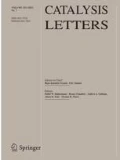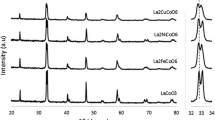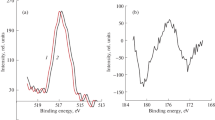Abstract
The electrical conductivity of barium and lead perovskites used as catalysts for the total oxidation of methane, has been measured under nitrogen, methane–nitrogen mixture, air and methane–air mixture (reaction mixture) at the catalytic reaction temperature. The two compounds appeared to be p-type semiconductors under air with positive holes as the main charge carriers but became n-type when contacted with methane–nitrogen mixture. Their conductivities differ by 1.5 orders of magnitude as n-type semiconductors and by three orders of magnitude when being p-type semiconductors. These results explained the difference in the catalytic activity encountered on the two solids. The alkane activation was proposed to be related in both cases to the p-type semiconducting properties of the solids, likely through hydrogen abstraction by a surface O− species, forming a CH •3 radical. The overall reaction mechanism on both perovskites can be assimilated to a Mars and van Krevelen mechanism.
Graphical Abstract
The electrical conductivity of barium and lead perovskites, catalysts for methane total oxidation, has been studied under different gaseous atmospheres at the reaction temperature and a reaction mechanism has been proposed.





Similar content being viewed by others
References
Herrmann J-M (1994) In: Imelik B, Védrine JC (eds) Catalyst characterization, physical techniques for solid materials. Plenum Press, New York ch. 20
Herrmann J-M, Vernoux P, Béré KE, Abon M (1997) J. Catal. 167:106
Marcu I-C, Millet JMM, Herrmann JM (2002) Catal Lett 78:273
Marcu I-C, Săndulescu I, Schuurman Y, Millet JMM (2008) Appl Catal A 334:207
Madeira LM, Herrmann JM, Freire FG, Portela MF, Maldonado FJ (1997) Appl Catal A 158:243
Madeira LM, Herrmann JM, Disdier J, Portela MF, Freire FG (2002) Appl Catal A 235:1
Millet JMM, Marcu I-C, Herrmann JM (2005) J Mol Catal A 226:111
Popescu I, Urda A, Yuzhakova T, Marcu I-C, Kovacs J, Săndulescu I (2009) C R Chim 12:1072
Heckelsberg LF, Clark A, Bailey GC (1956) J Phys Chem 60:559
Mars S, van Krevelen N (1954) Chem Eng Sci Special Sup 9:41
Acknowledgments
The authors are grateful to Dr. Éva Makó from the University of Pannonia for her XRD expertise and for unit cell parameters calculation. The Romanian National Authority for Scientific Research (ANCS) is acknowledged for the financial support of this work under the contract PN II nr. 105/15.09.2008.
Author information
Authors and Affiliations
Corresponding author
Rights and permissions
About this article
Cite this article
Popescu, I., Săndulescu, I., Rédey, Á. et al. Study of the Catalytic Activity–Semiconductive Properties Relationship For BaTiO3 and PbTiO3 Perovskites, Catalysts for Methane Combustion. Catal Lett 141, 445–451 (2011). https://doi.org/10.1007/s10562-010-0538-2
Received:
Accepted:
Published:
Issue Date:
DOI: https://doi.org/10.1007/s10562-010-0538-2




